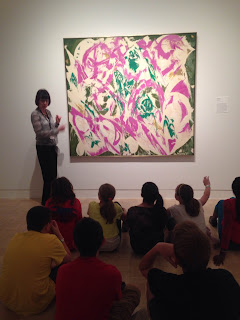My friend and doppelnamer Matt Miller wrote about this same event on his Ditch That Textbook blog. You should check it out, also.
It’s date night with my wife. We’ve got two young children. Dates don’t come often anymore. We decide to swing into an Orange Leaf Frozen Yogurt restaurant for some sweets.
It’s hot. They’re busy. We are waiting our turn to get some yummy froyo.
While waiting, I look at the people who have already received their yumminess. They’re chatting. Laughing. Eating. Stories are being told. Each group is having their own conversation, but no one is being too loud that it bothers any other groups.
There are multiple tables. Each surrounded by four chairs that look really comfortable. There are a couple sets of two couches facing each other. Each area has been specifically placed to allow groups of 4 to look at each other.
It hits me.
Orange Leaf has better learning spaces than I do in my classroom.
Communication - Each group of furniture is setup to initiate conversation between Orange Leaf’s patrons. Exactly what I want in my classroom. Two minds are better than one, right. Well, in this case, four minds are better than one. Could students talk about a topic in a more casual way? Does this setup provide for students to feel comfortable sharing about a topic?
Collaboration - Yes, these patrons are here to have a good time and have some yogurt. When thinking about my classroom, the way that this furniture is set up is conducive to having students work collaboratively. They are facing each other. There are no barriers in front of them to halt communication. Collaboration becomes easier through the communication that exists.
As I was leaving, and hoping the conversations I had with my wife were meaningful and not all about learning environments, I thought that it would be cool to have some furniture like that in my classroom.
Flashback to the spring and I was heading to a basketball coaching clinic and stopped in at a McDonald’s to get some breakfast on the way.
Sausage biscuit with egg. Large sweet tea. Thanks.
I look over and the “old-timers” are all sitting around shootin’ the breeze, talking politics, discussing the news on the TV and in the newspaper, and drinking lots of coffee. They are in an area that had been recently remodeled and looked similar to the feel of a Starbucks. It reminded me of philosophers in Ancient Greece debating life’s greatest questions.
At that time, what I didn’t really think of was how the environment directly affected the conversations that were being held. My classroom desks are usually set up in groups. Four to five students per group. My single classroom desks are separate from the chairs which makes them very easy to move, but I didn’t really think of the impact of having the actual desk in front of each student. It really just becomes something to sit things on. For the most part in my classroom is a Chromebook or the students’ notebooks. Can’t laps hold Chromebooks as well?
Back to the future.
I decide to tweet this out:
I'd love for my classroom to resemble an @myorangeleaf store. Would love their furniture in my classroom.
— Matt Miller (@dropstepdunk) August 10, 2015
Little did I know that Orange Leaf Headquarters would see it and reply with this:
@dropstepdunk Alright you got it. 👍🏼
— Orange Leaf Yogurt (@myorangeleaf) August 10, 2015
My principal at Cascade Middle School in Clayton, IN, Eric Sieferman, received word of what happened and he began talks with the powers that be.
A couple months later, with the amazing help of Orange Leaf and the Cascade Middle School PTO, a large semi-load of furniture arrived.
Then, with the help of Mr. Arnold’s Industrial Tech students that assembled a lot of the furniture and Mr. Rudd’s engineering, maintenance, and delivery services, the furniture made its way to our classrooms.
All in all, about 11 classrooms have some sort of Orange Leaf furniture in their rooms. I received three table groups (4 seats apiece) and 2 high top tables (2 seats a piece or students have liked to use them as standing desks).
Our old desks, which are a lot smaller and learning space friendly, went to improve the classrooms in the school that had older clunky, large desks.
Besides the generousness, kindness, and just downright awesomeness of Orange Leaf, one other really neat thing is the impact of Twitter.
It connects. I live in Indiana. Orange Leaf is headquartered in Oklahoma City. 750 miles away. How did this happen? A simple tweet saying that furniture like that would be really neat. Boom. It happened. How powerful is that?!
The final thing that has had a lasting impression on me is that you never know what will happen unless you’re willing to take the first step. The worst that could have happened is that Orange Leaf wouldn’t have responded. That would have had no impact on them, me, or my students and school. We just would have went on our 750 mile apart ways as if nothing had happened. The only thing is that in this situation, Orange Leaf said, “Alright, you got it.” I know that Orange Leaf is fully responsible for making this happen and having a certain type of people in leadership that values and invests in education. What I do wonder is if anyone had ever thought to combine the furniture and classrooms together? Learning spaces are evolving and changing. Sometimes it just starts with an idea. A thought. A vision.
I would like to personally thank Orange Leaf for helping me see a vision come to life. The impact that you have had on the culture of school will be evident for years to come.
Thank you.
 |
| Photo by Eric Sieferman |









